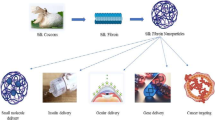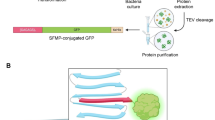Abstract
Silk fibroin derived from Bombyx mori is a biomacromolecular protein with outstanding biocompatibility. When it was dissolved in highly concentrated CaCl2 solution and then the mixture of the protein and salt was subjected to desalting treatments for long time in flowing water, the resulting liquid silk was water-soluble polypeptides with different molecular masses, ranging from 8 to 70 kDa. When the liquid silk was introduced rapidly into acetone, silk protein nanoparticles with a range of 40–120 nm in diameter could be obtained. The crystalline silk nanoparticles could be conjugated covalently with insulin alone with cross-linking reagent glutaraldehyde. In vitro properties of the insulin-silk fibroin nanoparticles (Ins-SFN) bioconjugates were determined by Enzyme-Linked Immunosorbent Assay (ELISA). The optimal conditions for the biosynthesis of Ins-SFN bioconjugates were investigated. The Ins-SFN constructs obtained by 8 h of covalent cross-linking with 0.7% cross-linking reagent and the proportion of insulin and SFN being 30 IU: 15 mg showed much higher recoveries (90–115%). When insulin was coupled covalently with silk nanoparticles, the resistance of the modified insulin to trypsin digestion and in vitro stability in human serum were greatly enhanced as compared with insulin alone. The results in human serum indicated that the half-life in vitro of the biosynthesized Ins-SFN derivatives was about 2.5 times more than that of native insulin. Therefore, the silk protein nanoparticles have the potential values for being studied and developed as a new bioconjugate for enzyme/polypeptide drug delivery system.







Similar content being viewed by others

References
Asada H, Douen T, Mizokoshi Y, Fujita T, Murakami M, Yamamoto A, Muranishi S (1994) Stability of acyl derivative of insulin in the small intestine: relative importance of insulin association characteristics in aqueous solution. Pharm Res 11:1115–1119. doi:10.1023/A:1018928613837
Asada H, Douen T, Waki M, Adachi S, Fujita T, Yamamoto A, Muranishi S (1995) Absorption characteristics of chemically modified-insulin derivatives with various fatty acids in the small and large intestine. J Pharm Sci 84:682–687. doi:10.1002/jps.2600840604
Baudys M, Uchio T, Mix D, Wilson D, Wan SK (1995) Physical stabilization of insulin glycosylation. J Pharm Sci 84:28–33. doi:10.1002/jps.2600840108
Grenha A, Remuñán-López C, Carvalho EL, Seijo B (2008) Microspheres containing lipid/chitosan nanoparticles complexes for pulmonary delivery of therapeutic proteins. Eur J Pharm Biopharm 69(1):83–93. doi:10.1016/j.ejpb.2007.10.017
Holle LM (1997) Pegaspargase: an alternative? Ann Pharmacother 31:616–617
Instruction of the INS-ELISA (KAP1215) kit from BioSource Europe S. A (8, Rue de I’Industrie, B-1400 Nivelles, Belgium)
Jintapattanakit A, Junyaprasert VB, Mao S, Sitterberg J, Bakowsky U, Kissel T (2007) Peroral delivery of insulin using chitosan derivatives: a comparative study of polyelectrolyte nanocomplexes and nanoparticles. Int J Pharm 342(1–2):240–249. doi:10.1016/j.ijpharm.2007.05.015
Kavimandan NJ, Losi E, Peppas NA (2006) Novel delivery system based on complexation hydrogels as delivery vehicles for insulin-transferrin conjugates. Biomaterials 27:3846–3854. doi:10.1016/j.biomaterials.2006.02.026
Krauland AH, Alonso MJ (2007) Chitosan/cyclodextrin nanoparticles as macromolecular drug delivery system. Int J Pharm 340(1–2):132–134. doi:10.1016/j.ijpharm.2007.03.005
Krauland AH, Guggi D, Bernkop-Schnürch A (2006) Thiolated chitosan microparticles: a vehicle for nasal peptide drug delivery. Int J Pharm 307:270–277. doi:10.1016/j.ijpharm.2005.10.016
Laemmli UK (1970) Cleavage of structural proteins during the assembly of the head of bacteriophage T4. Nature 227:680–685. doi:10.1038/227680a0
Lin W, Coombes AGA, Davies MC, Davis SS, Illum LJ (1993) Preparation of sub-100 nm human serum albumin nanospheres using a pH-coacervation method. J Drug Target 1:237–243. doi:10.3109/10611869308996081
Lin YH, Mi FL, Chen CT (2007) Preparation and characterization of nanoparticles shelled with chitosan for oral insulin delivery. Biomacromolecules 8:146–152. doi:10.1021/bm0607776
Müller GM, Leuenberger H, Kissel T (1996) Albumin nanospheres as carriers for passive drug targeting: an optimized manufacturing technique. Pharm Res 13:32–37. doi:10.1023/A:1016064930502
Reis CP, Ribeiro AJ, Neufeld RJ, Veiga F (2007) Alginate microparticles as novel carrier for oral insulin delivery. Biotechnol Bioeng 96(5):977–989. doi:10.1002/bit.21164
Sadayuk K, Hirokuni O, Mayumi K, Mamor K, Ruby P, Koshi M (1999) Fibroin allergy: IgE mediated hypersensitivity to silk suture materials. J Nippon Med Sch 66(1):41–44
Sakabe H, Ito H, Miyamoto T, Noishiki Y, Ha WS (1989) In vivo blood compatibility of regenerated silk fibroin. SEN-I GAKKAISHI 45(11):487–490
Santin M, Motta A, Freddi G, Cannas M (1999) In vitro evaluation of the inflammatory potential of the silk fibroin. J Biomed Mater Res 46(3):382–389. doi:10.1002/(SICI)1097-4636(19990905)46:3<382::AID-JBM11>3.0.CO;2-R
Sarmento B, Ribeiro A, Veiga F, Ferreira D (2006) Development and characterization of new insulin containing polysaccharide nanoparticles. Colloids Surf B Biointerfaces 53:193–202. doi:10.1016/j.colsurfb.2006.09.012
Sarmento B, Martins S, Ferreira D, Souto EB (2007a) Oral insulin delivery by means of solid lipid nanoparticles. Int J Nanomed 2(4):743–749
Sarmento B, Ribeiro A, Veiga F, Ferreira D, Neufeld R (2007b) Oral bioavailability of insulin contained in polysaccharide nanoparticles. Biomacromolecules 8(10):3054–3060. doi:10.1021/bm0703923
Weber C, Coester C, Kreuter J, Langer K (2000) Desolvation process and surface characteristics of protein nanoparticles. Int J Pharm 194:91–102. doi:10.1016/S0378-5173(99)00370-1
Yalow RS, Berson SA (1959) Assay of plasma insulin in human subjects by immunological methods. Nature 184(Suppl 21):1648–1649. doi:10.1038/1841648b0
Yin ZN, Lu B (2000) Study on Sustained Release Insulin Nanocapsules for Injection. Chin Pharm J 31(8):352–355
Zhang YQ, Ma Y, Xia YY, Shen WD, Mao JP (2006a) Silk sericin-insulin bioconjugates: synthesis, characterization and biological activity. J Contr Rel 115:307–315. doi:10.1016/j.jconrel.2006.08.019
Zhang YQ, Ma Y, Xia YY, Shen WD, Mao JP, Zha XM et al (2006b) Synthesis of silk fibroin-insulin bioconjugates and their characterization and activities in vivo. J Biomed Mater Res Part B Appl Biomater 79B:275–283. doi:10.1002/jbm.b.30539
Zhang YQ, Shen WD, Xiang RL, Zhuge LJ, Gao WJ, Wang WB (2007) Formation of silk fibroin nanoparticles in water-miscible organic solvent and their characterization. J Nanopart Res 9:885–900. doi:10.1007/s11051-006-9162-x
Zhang YQ, Xiang RL, Yan HB, Chen XX (2008a) Preparation of silk fibroin nanoparticles and their application to immobilization of l-asparaginase. Chem J Chin Univ 29(3):628–633
Zhang X, Zhang H, Wu Z, Wang Z, Niu H, Li C (2008b) Nasal absorption enhancement of insulin using PEG-grafted chitosan nanoparticles. Eur J Pharm Biopharm 68(3):526–534. doi:10.1016/j.ejpb.2007.08.009
Acknowledgments
The authors gratefully acknowledge financial support from National Basic Research Program, People’s Republic of China (contract grant number: 2005CB121000), Public Welfare Projects, People’s Republic of China (contract grant number: nyhyzx07-020), Natural Science Funds of Jiangsu Province, People’s Republic of China (contract grant number: BK2006053), and Medical developmental Funds of Soochow University, People’s Republic of China (contract grant number: EE120604).
Author information
Authors and Affiliations
Corresponding author
Rights and permissions
About this article
Cite this article
Yan, HB., Zhang, YQ., Ma, YL. et al. Biosynthesis of insulin-silk fibroin nanoparticles conjugates and in vitro evaluation of a drug delivery system. J Nanopart Res 11, 1937–1946 (2009). https://doi.org/10.1007/s11051-008-9549-y
Received:
Accepted:
Published:
Issue Date:
DOI: https://doi.org/10.1007/s11051-008-9549-y



